Intel Thunderbolt 4 Update: Controllers and Tiger Lake in 2020
by Dr. Ian Cutress on July 8, 2020 9:00 AM EST- Posted in
- CPUs
- Tiger Lake
- USB4
- Thunderbolt 4
- TB4

Wired connectivity is converging onto two standards: USB4 and Thunderbolt 4. Both of these are set to debut by the end of the year in Intel’s upcoming Tiger Lake platform, and to set the scene Intel is updating us on the scope of its Thunderbolt 4 efforts.
Thunderbolt 4 is going to be a superset of TB3 and USB4, meaning that any Thunderbolt 4 Type-C host will be able to accept TB4, TB3, USB4, and USB 3/2/1 connections. Thunderbolt 4 will offer speeds up to 40 Gb/s, and there are a number of requirements for Thunderbolt 4 hosts and devices in order to be certified.
These requirements include:
- Video, support 2x 4K or 1x 8K (No detail at what refresh/bit-rate/chroma)
- Data, PCIe at 32 Gbps (storage up to 3 GB/s)
- Support for TB4 docks with four TB4 ports (one upstream, 3 downstream)
- PC Charging on at least one port (for laptops up to 100 W)
- Wake from sleep by peripherals connected to a TB4 dock
- Requires Direct Memory Access protection (more on this later)
The first devices to come to market with TB4 support will be Intel’s Tiger Lake platform, for use in laptops, which will have TB4 baked right into the silicon. TB4 will be one of the base requirements for Intel’s Project Athena certification program, and Intel is set to release a new TB4 2m cable for most use cases. Intel is also working on optical 5-50 meter cables, which will also now support the TB4 multi-port accessory architecture, enabled by 4-port TB4 hubs.
There will be two host controllers, known as Maple Ridge JHL8540 and JHL8340, for use as host controllers in desktops, workstations, and laptops. We are told the package size and power requirements are essentially in-line with previous Titan Ridge TB3 controllers. The device controller, for use in docks, monitors, storage devices and such, is the Goshen Ridge JHL8440. All three of these controllers will be available by the end of the year.
Thunderbolt 4 has no costs associated with using it, the branding, or the logo, however there is a branding/logo license. Intel has opened up the TB4 standard, but as it stands is the only company that has publically announced its intention to make host and device controllers. The cables will be branded with the Thunderbolt Logo and a number 4, however ports on systems will only have the Thunderbolt Logo, making TB3 and TB4 use indistinguishable (we disagree with Intel that users don’t check what their system uses so using the same logo makes no difference to these users – we think the same argument can be used in order to showcase the logo on devices with the number 4).
Here’s a main slide showcasing the difference between all the different standards. Ultimately TB4 is backwards compatible with TB3 and USB4/3/2/1 standards.
One of the key focal points in our briefings with Intel is that Thunderbolt 4 will have an additional requirement this time round – Direct Memory Access protection to prevent physical attacks. In our briefing (and shown on the slide below), Intel initially stated that this requires Intel VT-d technology, which raised questions about Thunderbolt 4 being limited to Intel only systems.
The spokesperson later clarified that in order to gain certification, DMA protection is required, and Intel is using VT-d to do it. Intel refused to comment on how other vendors might implement DMA protection, stating that it would be up to them. While additional security protections are always a good thing, they ideally need to be based around open vettable standards, something which might limit Thunderbolt for another generation as an Intel-only technology (whereas USB is far more ubiquitous).
We’ve reached out to AMD late in the day, and they’ll be supplying a comment soon. I will update this post when I get something.
Update, AMD says the following:
The “Zen 2” architecture supports DMA security in pre-boot and OS environments via AMD-Vi (IOMMU) on USB and PCIe interfaces.
When asked specifically if AMD-Vi meets the requirements for TB4, AMD stated:
If the question is to do we support DMA? The answer is yes. Any questions about if this would satisfy another companies requirements for an interface they are developing would need to be directed at them.
When we asked Intel to confirm if AMD-Vi met the requirements for TB4's DMA protection, we were given the following quote:
Thunderbolt is open to non-Intel-based systems. Like any other system, devices must pass Thunderbolt certification and end-to-end testing conducted by third-party labs. Thunderbolt 4 requirements include Intel VT-d based or an equivalent DMA protection technology that provides IO virtualization (often referred to as IO Memory Management Unit or IOMMU), as well as OS implementation support. If the equivalent technology supports prevention against physical attacks, then that should meet the requirement.
Overall, TB4 seems like a very capable standard, providing backwards compatibility, top class speeds, as well as new connectivity topologies. It will be interesting to see what the additional cost of adding TB4 onto various systems will be with Intel’s controllers, especially in the desktop space.



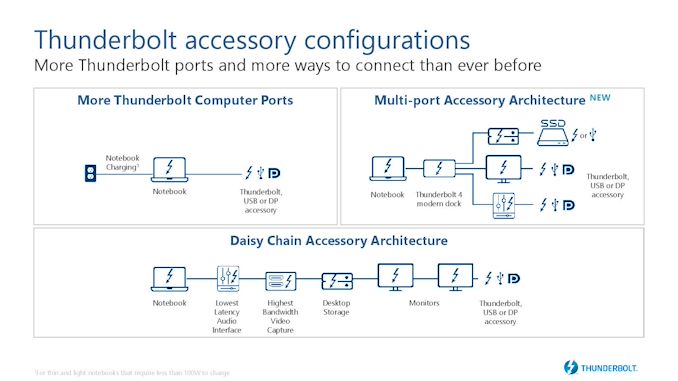
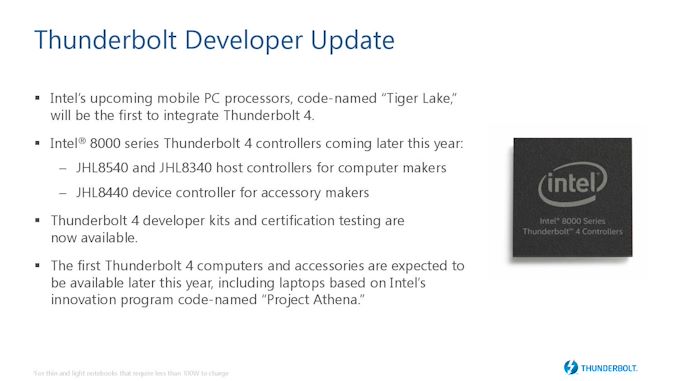

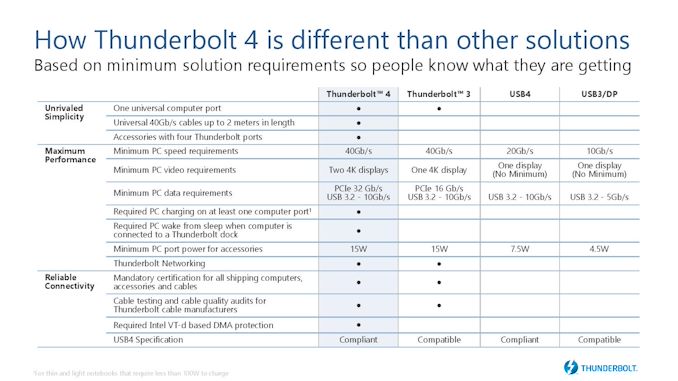
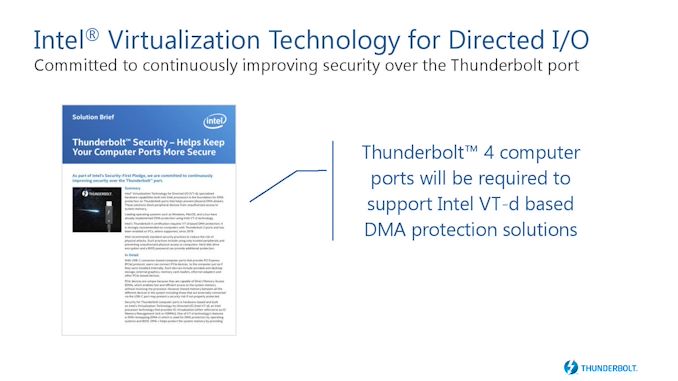
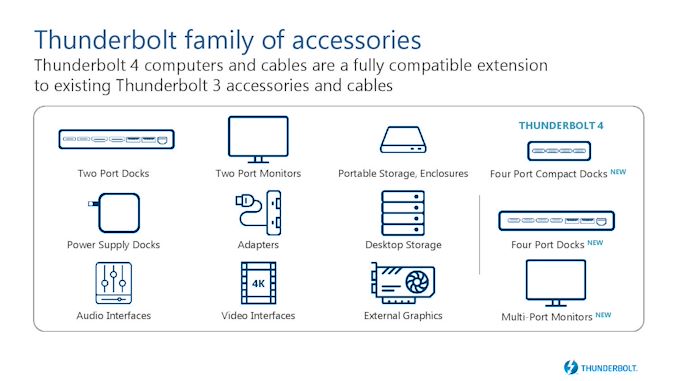














76 Comments
View All Comments
jospoortvliet - Thursday, July 9, 2020 - link
Yeah, it has to be checked on the side of the laptop, the cable AND the dock. It is absolutely insane - a USB 4 logo should mean a baseline of functionality - display, power etc - not this mess it is now.trenzterra - Tuesday, July 14, 2020 - link
Even manufacturers get it wrong sometimes. I bought a HP Pavilion laptop on the understanding the spec page and manual clearly showed support for PD charging. It didn't. Turned out they copy pasta'ed the specs sheet from an Envy laptop.voicequal - Wednesday, July 8, 2020 - link
TB4 seems to be going out of its way to be backward compatible with all other uses for USB-C. I'm not sure what your post is advocating on the HW side? Investing in one connector makes a lot of sense. See how far Ethernet has gone with 25 years of RJ-45: 10M/100M/1G/2.5G/5G/10G + PoE. Yes, better OS support and capabilities flags for multimodal interfaces can always help.Dock vendors are incentivised to highlight what they can do and be silent on what they can't, leaving the consumer to decipher the gaps. TB has always been a premium product, so you'll most likely to get the fullest capabilities from a TB dock, but rightly at higher cost than barebones USB hubs.
saratoga4 - Wednesday, July 8, 2020 - link
The thunderbolt port logo looks way too much like a charging/power supply icon for something that is suppt to be a data cable.Tomatotech - Wednesday, July 8, 2020 - link
FYI, it's also the charging port. (but only if you get the correct port ... )Tomatotech - Wednesday, July 8, 2020 - link
Edit: On Mac laptops with TB3, you can charge on any port. On Windows... flip a coin, especially if you're wondering which port to use on a dead laptop. (the jokes just write themselves ...)jeremyshaw - Wednesday, July 8, 2020 - link
Outside of TB3, some laptops with USB-C charging won't charge if the battery is completely flat. Pathetic. ASUS G14, if you are curious - only the barrel jack charger will work if the battery is below 3% or so.Mitch89 - Wednesday, July 8, 2020 - link
On Windows laptops there’s no guarantee any of the USB-C ports charge the machine, nor support DisplayPort Alt.My wife’s ASUS has a USB-C, but it’s no more useful than the USB-A port.
xenol - Wednesday, July 8, 2020 - link
It also supplies power. At this point it's ingrained in people's minds that USB is also a power supply port for their devices.The charging port is an issue, but it seems most laptops still use a typical barrel connector which I'd prefer.
jeremyshaw - Wednesday, July 8, 2020 - link
Up to 3GB/s (~24Gbps)? May you push them on that? It seems the annoying, seemingly arbitrary PCIe tunneling bandwidth limit is still basically the same (it was about ~2.75GB/s before, still a fraction of the total "40Gbps" they claim for TB3. It's all for naught if the only thing that can use all 40Gbps is Displayport...